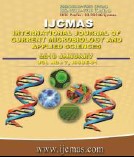


 National Academy of Agricultural Sciences (NAAS)
National Academy of Agricultural Sciences (NAAS)

|
PRINT ISSN : 2319-7692
Online ISSN : 2319-7706 Issues : 12 per year Publisher : Excellent Publishers Email : editorijcmas@gmail.com / submit@ijcmas.com Editor-in-chief: Dr.M.Prakash Index Copernicus ICV 2018: 95.39 NAAS RATING 2020: 5.38 |
Shrimp culture is the most lucrative food production sector in the world and it is having good commodity in international market. This review discusses about the microsporidians especially EHP their distribution, development, transmission, pathogenicity, diagnosis, treatment and prevention methods. EHP causes growth retardation in shrimp causing huge economic losses to shrimp culture. A prevalence of about 79.5% to 18.51% has been reported in many countries, majority from Southeast Asian countries. Till now there is no valid treatment available for shrimp farmers because EHP produces spores which are highly resistant and stable for long time in soil and water. It’s very difficult to eradicate once spores were in shrimp pond.so we concluded SPF brood stocks, strict pathogens quarantine and Standard management strategies could be the main approach to prevent entry of unwanted pathogens especially EHP.
 |
 |
 |
 |
 |